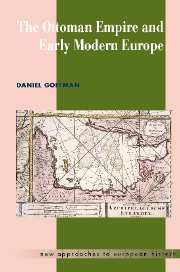Book contents
- Frontmatter
- Contents
- List of illustrations
- List of maps
- Preface
- Acknowledgements
- Note on usage
- Chronological table of events
- The Ottoman House through 1687
- 1 Introduction: Ottomancentrism and the West
- Part 1 State and society in the Ottoman world
- Kubad's formative years
- 2 Fabricating the Ottoman state
- Kubad in Istanbul
- 3 A seasoned polity
- Kubad at the Sublime Porte
- 4 Factionalism and insurrection
- Part 2 The Ottoman Empire in the Mediterranean and European worlds
- Glossary
- Suggestions for further reading
- Index
- NEW APPROACHES TO EUROPEAN HISTORY
Kubad at the Sublime Porte
from Part 1 - State and society in the Ottoman world
Published online by Cambridge University Press: 05 June 2012
- Frontmatter
- Contents
- List of illustrations
- List of maps
- Preface
- Acknowledgements
- Note on usage
- Chronological table of events
- The Ottoman House through 1687
- 1 Introduction: Ottomancentrism and the West
- Part 1 State and society in the Ottoman world
- Kubad's formative years
- 2 Fabricating the Ottoman state
- Kubad in Istanbul
- 3 A seasoned polity
- Kubad at the Sublime Porte
- 4 Factionalism and insurrection
- Part 2 The Ottoman Empire in the Mediterranean and European worlds
- Glossary
- Suggestions for further reading
- Index
- NEW APPROACHES TO EUROPEAN HISTORY
Summary
There is, at the end of a secret gallery, a small square window which serves as a listening post. It is a wicker-work grille, with a curtain of crape or black taffeta, and is called the “dangerous window,” because the prince may, whenever he wishes, listen to and see all that takes place, without being seen.
Before embarking for Venice, Kubad had to appear before the Imperial Divan to receive his documentation and verbal instructions. On a gloomy and drizzly morning in early September 1567, then, he rode from his home in Fatih, the quarter erected around the rather squat mosque of Mehmed II the Conqueror, nudging his mount along the slippery and uneven cobbled roads that twisted up and down the hilly city and across the grounds of the ancient Byzantine hippodrome. He circled to the right of the Hagia Sofia mosque and through the Imperial Gate into the first and most public of the three courtyards of Topkapı, the imperial palace. Here he dismounted and left his steed to be dried and fed at the imperial stables. As Kubad hurried along, he unconsciously noted his surroundings: to his left lay the ancient Byzantine church, Hagia Irene, as well as the mint, the hospital, and the imperial stables; and to his right towered the high wall that marked out the entire palace grounds. The imperial official, however, walked straight ahead, toward a second portal, the Gate of Salutation.
- Type
- Chapter
- Information
- The Ottoman Empire and Early Modern Europe , pp. 93 - 97Publisher: Cambridge University PressPrint publication year: 2002

